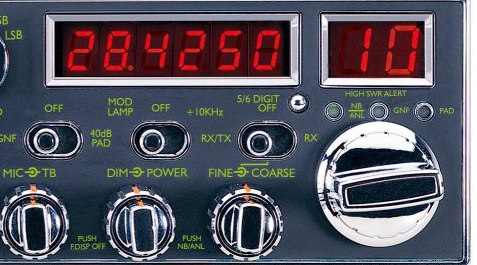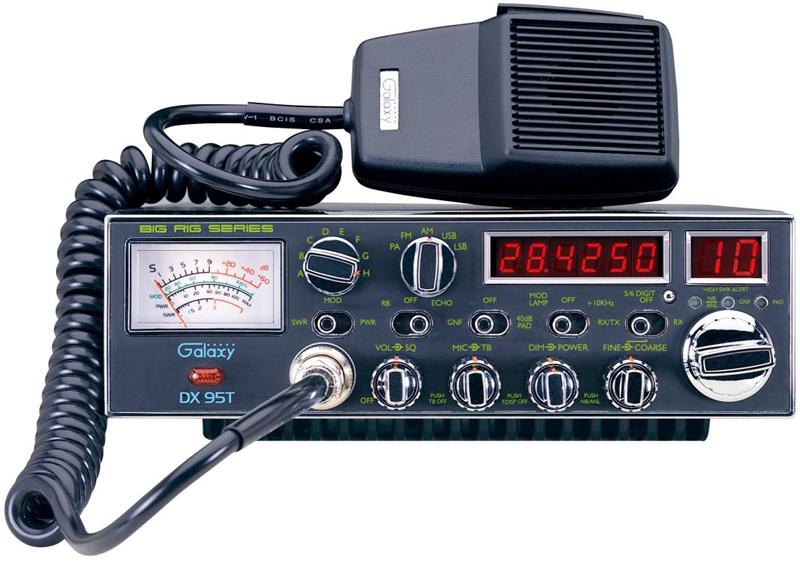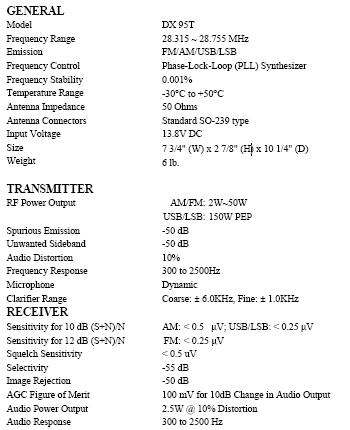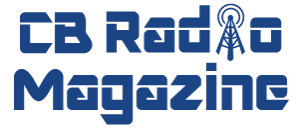Galaxy 95T AM/FM/SSB Export Radio Review


The Galaxy DX 95T is a large, expensive, and powerful radio loaded with great features.
Will you ever own one? That depends on the size of your wallet.
For most people $400 is a lot of money. Good luck telling your wife that you’re spending that much money on a CB radio (or export radio to be technically correct).
Now, if you can get past the price you’re going to be rewarded with one of the best high power export radios on the market.
HIGH POWER RADIOS
In the CB world of past when you wanted more power for your setup you had to add a amplifier which also meant you needed extra power wires and extra coax. You had to match your radio’s output to the amplifier input. Overall it’s not a hugely difficult task, but it does require a bit of work.
The other issue for many drivers was that amplifiers take up extra room and often it was difficult to find a easy place to mount one. A lot of people will mount amplifiers under seats or in trunks, but then they become hard to reach. A lot of truck drivers switch rigs on a regular basis and they have to be able to take their radio with them from truck to truck; not easy when you’re lugging all those wires and extra equipment.
So out of these issues came the advent of the high powered 10 meter radio.
A CB radio has a legal output of 4 watts and so manufactures legally couldn’t make them any more powerful. 10 meter radios on the other hand fall into a different category and so the manufacturers decided to create an export radio that would have a built in amplifier and could produce higher output wattage.
The first attempts were popular, but major issues immediately became apparent. Amplifiers create heat and these new radios were experiencing excessive buildup of heat inside the units. Heat kills electrical components and these new radios started feeling the effects with many lasting less than a year before failing.
The manufactures realized they needed to find a way to keep the radios cool and isolate the amplifier section away from the rest of the radio.
Eventually the concept was perfected and today we have radios such as the RCI 2970DX and the Galaxy 95T. These radios use dual transistor amplifier systems that are mounted in a separate area on the bottom radio cover. They utilize large heat sink fins and cooling fans.
FEATURES OF THE GALAXY 95T
When you’re paying top dollar for a top of the line radio you expect that it will have all of the regular features and more. The Galaxy 95T doesn’t disappoint.

Let’s list out the control features found on the face of the radio –
- Volume
- Squelch
- Mic Gain
- Variable Talkback control / Talkback on/off
- Variable Dimmer
- Variable Power Output
- Fine/Coarse tuning
- NB/ANL
- SWR/MOD/PWR switch
- Roger Beep
- Echo
- (GNF) Galaxy Noise Filter
- 40db Pad
- Modulation Lamp
- +10 KHZ switch
- RX/TX & RX Tracking control
- 5/6 digit control
- A-H bands of channels
- AM/FM/LSB/USB/PA
- High SWR Alert
- 6 digit frequency counter
- Large Meter
- Starlite Faceplate
Now that’s a lot of features in one radio, but Galaxy did a good job of spacing them out and having many controls with dual features.

A couple of these features really stand out to me –
Variable Power Output – This is always an important one to me. If you can talk to someone using 50 watts than there’s no need to put out 100 so being able to adjust my output wattage is nice.
Echo – This radio has echo on a switch, the adjustments are located inside which is a pain to set, but at the same time once you find a good setting it’s nice to know you won’t be bumping the controls or messing up your echo delay.
GNF – The Galaxy noise filter is an interesting feature. It de-emphasizes audio high frequency response in order to increase signal-to-noise ratio of weak signals. After using it I’m not still 100% sure how well this feature works.
6 Digit Frequency Counter – For sideband operation this is a must have.
Starlite Faceplate – When you look at your radio every day you better like the way it looks. At night time I’d be hard pressed to find a radio that looks better than the 95T. The Starlite lights up all the controls without making your radio look like an obnoxious Christmas display.
There’s no doubt this radio is loaded with features, but the key is that they really picked the most popular features so that the radio can appeal to the needs of just about any CB’er in the market.
The only features this radio is really lacking in my opinion is the ability to store memory frequencies, but if you need that you probably should be looking towards the RCI 2970DX.
We could write out more about the features here, but since there are so many and it’s better to see them in action I’ve gone through them in detail on the video at the end of this review.
BIG POWER
The Galaxy 95T uses two Toshiba 2SC2290 transistors which give it up to 150 watts of output. Compared to people running 1,000 watt amplifier this may not sound like a whole lot of power, but the truth is that when you talk about increasing output wattage the first 100 watts is really the most important.
As we know from reading the Power in Perspective article – going from 4 watts to 100 watts yields about a 335% increase in distance or 67 miles, but moving upward further to 450 watts only takes us to 87 miles.
Using that information and looking at the graph we can tell that a radio with 100+ watts of output is going to be a big improvement over 4 watts and the Galaxy 95T is the perfect example.
After using this radio for a month I can say that the output of the radio is great for local talking as well as making DX contacts. I’ve been able to talk on the bowl (CH 6) with many of the big strappers using just the 95T. On SSB the radio really shines and making contacts becomes almost routine.
Although there are AM radios out there that now can do 300+ watts the 95T really is more efficient in my mind in the sense that it takes advantage of the optimum output for making contacts.
Two 2SC2290 transistors working hard for 20 mins will get hot though and the radio does have a great cooling system. It uses a heat sink on the bottom matched up with a micro cooling fan to move the heat away from the transistors and important components of the radio.
The amplifier system is housed in it’s own compartment which again helps to isolate the heat as well as any RF interference from having negative effects on the main radio unit.
I’ve heard claims of Galaxy 95T radios doing 200+ watts and while it may be possible to reach large numbers for output, the increase in power isn’t worth the additional wear it causes to your $400 unit. After laying down that much cash do you really want to risk causing damage by pushing your radio to the limit?
AUDIO
Big audio.
That statement really sums up everything there is to say about the Galaxy 95T. If you’ve used Galaxy radios in the past than you’re aware that they have loud audio. People on the other end of a Galaxy radio are hearing excellent modulation and if done right, minimal distortion (although I’d say at least half of the people running Galaxy radios are over-modulated due to poor tune ups).
The 95T doesn’t take a whole lot to produce excellent modulation and audio on the other end. Most technicians will turn up the modulation potentiometer inside the radio and then let the user adjust the amount of gain using the mic gain control.
While many people get in the habit of throwing a power microphone on every radio they own, I’d really suggest picking your microphone carefully for the 95T. Power microphones have been known to create issues with the 95T. I noticed with a couple of the power microphones that they easily pushed the radio into the over modulated and distorted category or caused background humming or feedback. This was especially true with the cheaper models. After your radio has been tuned make sure to try out some stock microphones and some power microphones to see what is going to work best for you.
RECEIVE
The 95T has excellent receive along with noise blanking abilities. After testing in three different vehicles I had no issues with engine noise and found the unit to be very quiet, even in more urban city areas where there is more electrical interference.
Stations were easily heard, although I will say that some of the very far off stations sometimes came in right at the static level and weren’t discernable whereas they were on more expensive ham radio equipment. I only experienced this once or twice with locals who are more than 65 miles away, so the other 99% of the time this radio allowed me to hear everyone I wanted.
The speaker on this radio is smaller than many other units but it still does a good job of reproducing sound. Quality wise I only noticed a small difference in the way locals sounded with the smaller speaker. Of course a nice high end DSP external speaker will give you a much better reproduction and can easily be plugged into the radios external speaker jack.
One of the interesting things about this radio is that it doesn’t have an RF gain control. For some people this might be an issues. Personally I only ever touch my RF gain when I end up driving right next to a couple of other rigs and I don’t want my unit to be overloaded.
I do know a lot of operators who like to turn down the RF gain just a little to cut out some of the static level; not possible on this radio.
But Galaxy did take care of the overloaded signal issue by adding a 40db pad switch function. Moving the switch to this position will help prevent overloading when you are in close vicinity to other stations.
I tried the GNF (Galaxy Noise Filter) on multiple occasions on SSB and in most cases the filter lowered the tone so much that it made it more difficult to understand the stations than without it. After messing with it for a month I’ve kept it off and decided that it is not a feature I intend to use.
FREQUENCY DRIFT
One of the big complaints about Galaxy SSB radios over the years has been their tendency to drift off frequency. With radios such as the 99V or 88HL this was a fairly common issue. Even on more recent radios such as the 959 there have been reports of some drift although not as severe as the older models.
The Galaxy 95T is by far the most stable Galaxy radio I’ve tested in regards to sideband stability. After testing both as a mobile and a base I found that this radio is excellent for SSB operation and drift is minimal. I did notice on a couple of occasions that the frequency counter 6th digit had gone down one place during the first 45 minutes of use, but once the radio reached it’s operating temperature I didn’t experience any issues and didn’t touch the clarifier again.
The 95T definitely doesn’t fall into the same export “drift” category as previous radios I’ve tested like the SS-158EDX.
OVERALL
While I usually prefer to run a radio + amplifier I may have finally found a radio that has changed my mind. When a company can produce such a perfect package of features and power it’s difficult to resist buying one.
The radio performed well in all respects. Power output was perfectly adequate for me to talk local or DX (I made quite a few contacts in the last month); the receive was excellent and I had no trouble hearing DX stations; the features were fun and I experimented with the echo, talkback, and modulation light. And I’m sold on the Starlite feature, the faceplate just looks awesome at night.
Truthfully my only reservations about this radio are based on the historic problems associated with radios that had built in amplifiers. I find it necessary to remind myself that these newer radios have better heat sinks and designs, including fans to help prevent buildup of heat that leads to failures.
Aside from my unfounded worries and some very slight drift on SSB I’ve enjoyed using the Galaxy 95T. It still has the classic CB styling but brings the user all of the newer features that we’ve come to expect.
Many ham radio operators have made the comment that “for $400 why not buy a ham radio that can cover ham frequencies and has better receive?”, but that’s not what CB’ers want. The reason CB’ers buy the 95T is because it has the features they want without the stuff they don’t. CB’ers don’t need 80 meters or computer interfaces. It’s the same reason why ham radio operators don’t buy expensive 10 meter export radios.
CB’ers like big AM audio, echo and talkback controls, along with solid power for making contacts. For $400 you’re getting the very top of the line export radio that has ALL of the CB features you want plus some serious output power.

CLICK HERE TO VIEW THE GALAXY DX 95T OWNERS MANUAL
For a picture of alignment locations click HERE
Here are some notes and details from the Galaxy website –
- A High-Performance output circuit that uses two Toshiba 2SC2290 power transistors to generate 50 watts for AM/FM and 150 watts for SSB operation
- Chassis incorporates a solid aluminum finned rear section as a heatsink
- Additional heat sink on the bottom of the radio with an internal Micro cooling fan increases the radio height from 2.5 to 3 inches
- Same main circuit board as our DX 2517, DX 93T, DX 48T and DX 45MP
- “StarLite” faceplate is matte black with all lettering backlit in green and blue
- Switchable sixth digit provides five or six digit frequency display
- Our exclusive “SuperSlider” circuit maximizes frequency control by switching the Fine clarifier between Receive/Transmit and Receive Only operation or completely out of the circuit with one slide switch. The Coarse clarifier operates on both receive and transmit unless the SuperSlider switch is off. When switched off, both clarifiers are out of the circuit.
- Retro-look red modulation lamp (with On/Off switch) flickers like the old neon lamps of the Fifties and Sixties
- Front mic jack
- Variable power output control
- Red channel and frequency digits
- Heavy duty DC power cord
Strange and Unusual Features:
- The echo has internal controls only. It is our famous dual control echo circuit without any controls on the front panel. The On/Off switch is there, but to adjust the echo sound, the bottom cover must be removed. Locate the rectangular metal box containing the echo board. Do not open this box. Use a small plastic tuning tool to gently adjust the trimmer pots inside the holes marked “ECHO” and “TIME.” These pots are somewhat fragile so it is best not to use a metal screwdriver.
- A single slide switch controls both the Echo and the Roger Beep. They can both be off, but they cannot both be on at the same time.
- There is no receive gain pot. A 40dB attenuator switch takes its place.
The DX 95T also has the following standard features found on most other Galaxy radios :
|
|


https://www.youtube.com/watch?v=0waTn1wFkLw
